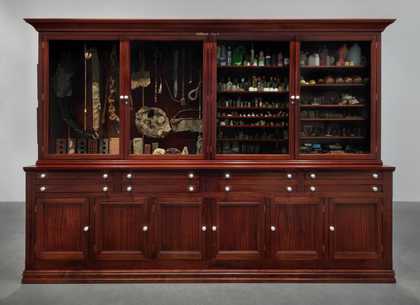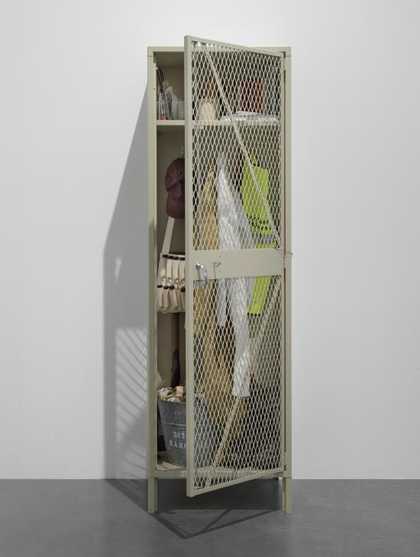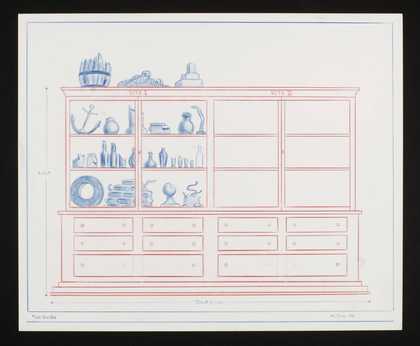Joseph Conrad's celebrated story Heart of Darkness, written in the last year of the nineteenth century, begins with a description of the River Thames. The narrator, Marlow, is on board the yawl Nellie ready to set sail: 'The day was ending in a serenity of still and exquisite brilliance' and 'the old river ... rested unruffled'. Marlow and the rest of the crew are waiting for the tide to turn and night to fall, in order to commence their journey. He suggests that all rivers and seas run into one another and observes that the Thames 'stretched before us like the beginning of an interminable waterway', and so establishes a connection between London and the destination of his tale, the Belgian Congo.
It seems appropriate to begin a discussion of Mark Dion's most recent project, the Tate Thames Dig with a reference to Conrad's tale. Both offer a portrait of the city of London through its heart, the river, and like Marlow, Dion has often assumed the role of adventurer attempting to obtain a deeper understanding of the world.
Mark Dion is an American artist whose work incorporates aspects of archaeology, ecology and detection. He is fascinated by the principles of taxonomy, the systems of classification by which people have sought to bring order to the world. Dion has been particularly influenced by the work undertaken by nineteenth-century naturalists, such as Charles Darwin and Alfred Russell Wallace, co-founders of the theory of natural selection. His own investigations 'have led him to construct laboratories and experiments and to embark on expeditions to the tropics.
During the summer Dion, and a team of volunteers drawn from local community groups, combed the foreshore of the Thames at low tide along two stretches of beach, at Millbank and Bankside. The finds from these two very different sites were meticulously cleaned and classified in archaeologists' tents on the lawn of Tate Gallery, Millbank. In the course of this process a profile of the city was built up through its one constant, and reason for being, the river.
While archaeologists have found evidence of pre-Roman settlements and trade in the Greater London area, it was not until AD50 that London was established as a permanent political and trading town. Its location on the north bank of the Thames was geographically determined by the need to find a site where the wide and meandering river was narrow enough to bridge and where the bridge's southern point would rest on firm sandy land. This was found between the creeks and mudflats of what became Southwark -close to the site of the future Tate Modern.. Such was the success of the choice of location for the first bridge that until 1750 all subsequent bridges were built within a few metres of it.
Southwark, one of London's oldest suburbs, was for centuries the home to the leather and fur industry, in addition to glass, metal and ceramic works, all of which benefited from the arrival of skilled Huguenot immigrants from Europe in the seventeenth century. By then it had become the centre for entertainment, which ranged from gambling and bear baiting, to visits to dicing houses, theatres such as the Globe, and brothels which were situated conveniently nearby. Upstream at Millbank, the marshy plains were for centuries considered to be a remote, barren and dangerous area on the outskirts of the city. This sense of waste land was reinforced in the early nineteenth century when it became the site of Europe's largest prison and depot for convicts en route to the Antipodes.
Given that London's existence and until this century, much of its success, can be attributed to the Thames, it is no coincidence that the lives of its inhabitants have been intimately linked to the water. In the Tate Thames Dig this is reflected in the discoveries from the two sites, displayed by location in a double-sided old-fashioned mahogany cabinet, alongside photographs of the beachcombers, and tidal flow charts. Crowded with treasures and curiosities in apparently arbitrary and unexpected arrangements, the viewer is left free to make an individual journey of discovery. The potency of these objects lies in their associations; the gallery being transformed into a repository of lost history, fantasies and remembered lives.
Sherds of Delft pottery, bone and glass lie side by side. A Pret a Manger soy sauce bottle in the shape of a fish sits comfortably next to a fossilised sea urchin. An assortment of nails confirms the presence of London's first shipyards established during the reign of Henry VIII, whereas a sinister wax effigy hints at a continuing tradition of offering to river gods. Here, the conventions of museum display are turned upside down to reveal the human element in scientific analysis -a process that often adopts a cold and impersonal façade. These conventions were formalised in the nineteenth century, coinciding with the development of the theory of evolution and the Victorian progressive ideal of presenting history in a linear order of increasing complexity.
Dion is influenced by the writings of the contemporary evolutionary theorist Stephen Jay Gould, who points out that all taxonomic systems are rooted within our social structures. By adopting the role of the archaeologist and re-enacting the very processes of traditional scientific research, Dion investigates the premises upon which these activities are based. In contrast, he proposes a broader exploration of the natural sciences; a reworking of orthodox procedures of collecting, identifying and classifying to suggest a more poetic and open-ended approach to interpretation.
Like a good detective, Dion revels in seeing beyond individual fragments to recognise larger patterns; making connections between often seemingly unrelated objects and events. Through the careful juxtaposition of the finds from the Tate Thames Dig, Dion creates new layers of meaning, linking our thoughts to the constructions of the past and choices for the future. True to the idea that the proper study of mankind is man, Dion leads us through the byways of natural history and comparative anatomy to bring us back time and time again to see ourselves, illuminated by this new and deeper knowledge, and to reassess our position within the current order of things.
Text written by Clarrie Wallis
Biography
Born New Bedford, Massachusetts Lives in Beach Lake, Pennsylvania.



